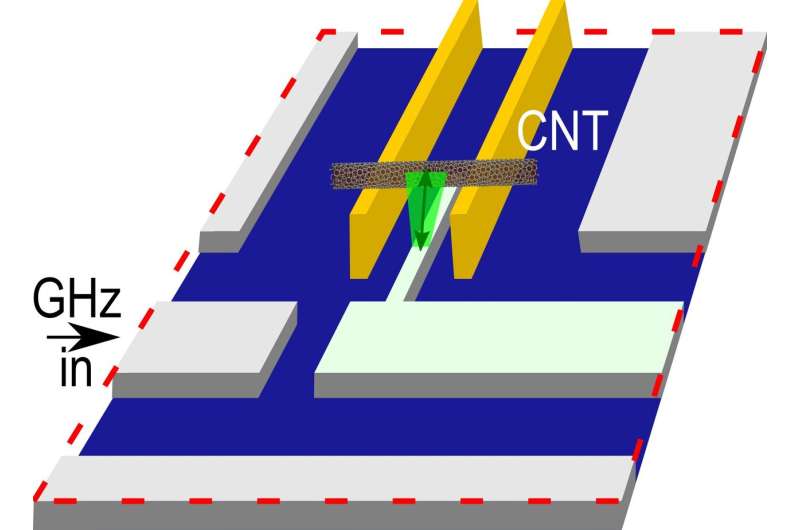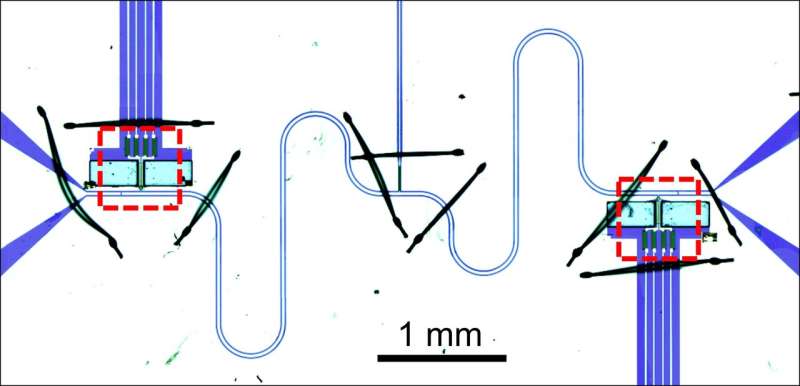Towards a nanomechanical quantum switchboard

Physicists at Universität Regensburg have coupled the vibrations of a macromolecule—a carbon nanotube—to a microwave cavity, creating a novel and highly miniaturized optomechanical system. The team of Dr. Andreas K. Hüttel achieved this by using the quantization of the electrical charge, i.e., that it is carried by single electrons, as a strong amplifier mechanism. Their findings were published on April 2 in Nature Communications. They present an important step towards combining completely different quantum technologies, as, e.g., electron spin qubits and superconducting qubits, in one device.
Normally, coupling the motion of a macromolecule such as a carbon nanotube to microwaves is hard. Why? Because electromagnetic wavelengths used in quantum computing or cavity quantum electrodynamics devices, working at GHz frequencies, are in the millimeter range. A typical nanotube device, useful both for trapping electrons in known quantum states and as a vibrational resonator, is less than a micrometer long, with vibration amplitudes below a nanometer. As a result of this mismatch of sizes, the motion of the nanotube just does not modify the electromagnetic field of a microwave cavity much. The coupling predicted by standard optomechanical theory is minimal.
Still, achieving such a coupling and controlling it, without driving the nanotube to large vibration amplitudes, is for many reasons an attractive idea. A nanotube is an excellent string resonator, storing energy for a long time; its vibration could be used to translate quantum information between fundamentally different degrees of freedom. And both single trapped electrons and superconducting microwave circuits are hot candidates for quantum computation architectures.

The Regensburg experiment, published as an open-access article, has shown that the interaction between the two systems, vibration and electromagnetic field, can be amplified by a factor of 10,000 compared to simple geometric predictions. This is achieved by using so-called quantum capacitance: current is carried by discrete electrons, which means that charging up a very small capacitor, such as a nanotube, does not happen continuously but rather in steps. By choosing a working point on the step-like curve, the optomechanical coupling is controllable, and can be switched on and off quickly.
"We implement a so-called dispersively coupled optomechanical system—novel and exciting on one hand because of the miniaturization of the mechanical part and the single electron effects, but well known on the other hand, since a huge body of theoretical and experimental research on larger (up to macroscopic scales) optomechanical systems exists," says Dr. Hüttel, currently on a research stay at Aalto University, Finland. "Optomechanical interaction can be used for cooling of the vibration, for detecting it in a highly sensitive way, for amplification of signals, or even for arbitrary preparation of quantum states. Our results indicate that quantum control of the string-like nanotube vibration will be reachable in the near future. And that makes it very attractive as a kind of quantum switchboard, combining very different quantum phenomena."
More information: Stefan Blien et al. Quantum capacitance mediated carbon nanotube optomechanics, Nature Communications (2020). DOI: 10.1038/s41467-020-15433-3
Journal information: Nature Communications
Provided by University of Regensburg




















